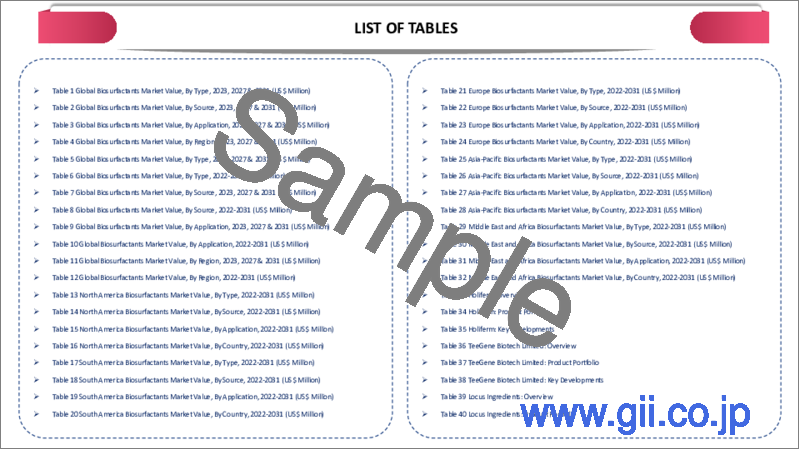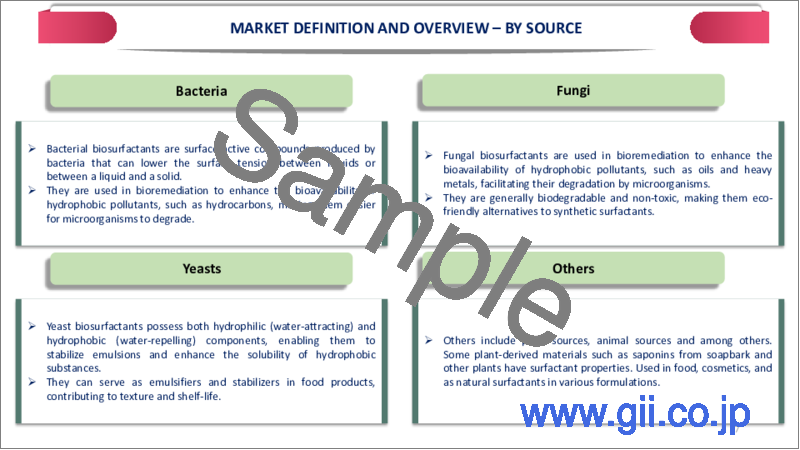|
|
市場調査レポート
商品コード
1560877
バイオサーファクタントの世界市場:2024年~2031年Global Biosurfactants Market - 2024 - 2031 |
||||||
カスタマイズ可能
適宜更新あり
|
|||||||
| バイオサーファクタントの世界市場:2024年~2031年 |
|
出版日: 2024年09月23日
発行: DataM Intelligence
ページ情報: 英文 208 Pages
納期: 即日から翌営業日
|
- 全表示
- 概要
- 目次
レポート概要
世界のバイオサーファクタントの市場規模は、2023年に12億4,000万米ドルに達し、2031年には26億6,000万米ドルに達すると予測され、予測期間2024年~2031年のCAGRは10%で成長する見込みです。
低毒性、生分解性、環境との高い適合性は、天然界面活性剤が合成界面活性剤と比較して持つ多くの利点のほんの一部に過ぎません。バイオサーファクタントの市場は、農業、パーソナルケア、医薬品、食品を含む様々な産業において、環境に優しく持続可能な製品に対する需要が高まっている結果、安定した速度で拡大しています。
また、バイオサーファクタントは、飲食品業界、医薬品業界、農業業界、化粧品業界、石油回収業界など、幅広い業界で使用されています。バイオサーファクタントの世界市場拡大には、いくつかの要因があります。その要因には、バイオサーファクタントの適応性や、明確な用途において従来の界面活性剤を代替する能力が含まれます。
米国国家統計局の発表によると、石鹸や洗剤、洗浄剤や研磨剤の生産による収益は、2023年までに約61億3,181万米ドルに達すると予想されています。英国のオフショア石油産業は、英国が成熟した石油地帯であるにもかかわらず、近年で最も深刻な石油価格の低迷に直面して、その粘り強さを示しました。
市場力学
環境問題の高まり
界面活性物質の利用は広く普及しており、その消費量は人間の人口や活動と並行して増加しています。これらの化合物の主な用途は、歯磨き粉やシャンプーなどの洗剤製品、脱脂、農業、採油、その他の関連分野です。界面活性剤は、主に洗浄剤やその他の洗剤溶液に含まれる化合物の広いカテゴリーです。
残留界面活性剤は下水道や地表の水路に直接排出され、その大部分は最終的に土壌や堆積物、その他の水域に沈殿します。河川、廃水処理場、海に界面活性剤が存在し、その消費量は年間1,500万トンを超えるため、生態系への懸念は社会的に大きな問題となっています。重大な懸念は、未処理の廃水や最低限の処理しか受けていない廃水の放出です。
高濃度の界面活性剤を含む廃水が排出された場合、環境に深刻な影響を及ぼす可能性があります。廃水を回収し、処理し、再利用に向けて再送するためには、包括的な水処理プロセスが必要です。生分解性の制限、毒性、富栄養化、アレルゲンなど、界面活性剤を取り巻く環境問題は、より多くの研究と革新的なバイオベースの界面活性剤の開発に拍車をかけています。界面活性剤は、二酸化炭素の排出や大気中の温室効果ガスを削減する上で重要な役割を担っています。
製造技術の欠如
バイオサーファクタントの適切な製造技術の欠如は、バイオテクノロジーと産業応用の領域における重要な課題でした。商業化の主な障壁のひとつは、製造コストです。現在、いくつかのバイオサーファクタントの製造コストは、合成品のそれを上回っています。
このコスト差は、専門菌株、発酵プロセス、下流の精製技術に対する需要の増加によって生じています。費用対効果の高い製造方法の開発は、企業の成功にとって極めて重要です。バイオサーファクタントの生産に必要な培地や原料の十分な入手可能性と適正な価格設定が不可欠です。
発酵ブロスからのバイオサーファクタントの回収と精製には課題があり、高いコストがかかります。最適な純度の製品を提供するには、効率的な下流工程が必要です。さらに、生産プロセスの最適化やバイオサーファクタントの新たな用途開発の進展は、この分野の研究開発への資金不足によって妨げられています。
市場セグメンテーション
世界のバイオサーファクタント市場は、タイプ、用途、地域によって区分されます。
用途別では洗剤が市場を独占
洗濯や家庭用洗浄液の調合は、その過程で重要な役割を果たす界面活性剤に大きく依存しています。現代の洗剤は、化学界面活性剤、柔軟剤、酸化剤、各種酵素など、さまざまな成分で構成されています。しかも、界面活性剤はすべて合成的に製造されており、まだ未熟な水生生物にとっては危険なものです。
広いpH範囲(7.0~12.0)で安定であることに加え、環状リポペプチド(CLP)のようなバイオサーファクタントは、高温に加熱しても表面力学的特性を失いません。市販の衣料用洗浄剤との類似性と強度の高さ、植物油との卓越したエマルジョン生成能力の高さから、衣料用洗浄剤の戦略を立てる際に考慮することが推奨されます。
2021年、パーソナルケア・洗剤工業会(IKW)は、ドイツにおける洗濯用洗剤とクリーニング用品から生み出される収入が50億9,200万ユーロに達し、これは約60億2,460万米ドルに相当すると報告しました。これは前年の52億4,600万ユーロ(約59億9,000万米ドル相当)を大幅に上回る数字です。
地域別の市場シェア
欧州におけるグリーン界面活性剤への消費者意識の高まり
カーボンフットプリントの削減を目的とした代替グリーン界面活性剤の利用に関する製造業者の意識の高まりが成長を後押しすると予想されます。有害な副産物を生成したり、生物学的分解の結果として環境に毒素を放出したりする可能性のある化学物質の消費を禁止する法律の増加も、成長を押し上げると予想されます。
欧州委員会が述べているように、欧州連合(EU)共同体が最初に洗剤への界面活性剤の使用を制限する政策を制定したのは1970年のことです。これは、海洋生態系に悪影響を及ぼす水系での泡立ちの問題に対処するために行われました。長い年月を経て、ドイツの人口は増加し、国民は個人の清潔さとケアに対する高い意識を持っています。
その結果、石鹸と洗剤の消費量が大幅に増加しています。予測期間中、これによって界面活性剤の利用が増加すると予想されます。ドイツの化学産業が製造する製品は、石鹸、洗剤、化粧品など、さまざまな製品に欠かせません。洗浄、ケア、洗濯用品を製造する60以上の企業がドイツ国内にあります。
化粧品マーケティング企業協会(VKE)の報告によると、ドイツの化粧品業界は2021年に前年比0.4%増となり、2020年の9%減を大幅に上回りました。顧客の関心を維持しようとするメーカー間の激しい競争の結果、英国の石鹸・洗剤製造事業の市場はダイナミックなものとなっています。
市場競争情勢
同市場の主な世界的企業には、Evonik Industries AG、Deugan Biosurfactant Supplier、Biotensidon GmbH、Saraya Co.Ltd.、Allied Carbon Solutions Co.Ltd.、Daqing VICTEX Industries Co.Ltd.、Jeneil Biotech, Inc.、BASF SE、Holiferm Limited、Solvay S.A.などがあります。
ロシア・ウクライナ紛争影響分析
ロシア・ウクライナ紛争は、主に原材料とエネルギーの入手の中断により、バイオサーファクタント部門に多大な影響を及ぼしています。欧州、特にドイツの有機化学企業は、エネルギー消費と製造業務の両面で天然ガスに大きく依存しています。エネルギー費の高騰とガス配給の可能性をもたらす紛争が続く中、企業はかつてない困難に直面しています。
生産停止の発動は、企業経営者の慎重さを高める結果となり、ドイツにおけるビジネスへの期待の大幅な低下に表れています。ロシアからのエネルギー源が予測できないため、バイオサーファクタントの合成など、いくつかの産業用途に不可欠なアンモニアのような重要な化学製品の生産量が減少しています。
特に、BASFとYaraはすでにアンモニア生産の削減を宣言しており、バイオサーファクタントの製造に不可欠なこの成分の入手に直接影響しています。エネルギー価格の高騰と予測不可能なサプライチェーンの中で、バイオサーファクタント部門は、生産中断の可能性とコスト上昇を特徴とする危険な未来に直面しています。
主な発展
2022年6月、エボニックインダストリーズAGはスロバキアのスロベンスカ・ユプカで商業用ラムノリピッド製造プラントの建設を開始しました。この新しいバイオサーファクタント施設の設立を通じて、同社は高品質で環境に優しいバイオサーファクタント製造の先駆者としての地位を確立することを目指しています。
BASF SEは2022年3月、子会社ケアクリエーションズが大豆タンパク質から合成した陰イオン界面活性剤「プランタポン・ソイ」の創出に成功したことを明らかにしました。このバイオベースの界面活性剤は、パーソナルケアと化粧品分野にいくつかの環境上の利点を提供します。
2024年1月、米国を拠点とするバイオサーファクタント製造会社ホリフェルムは、持続可能なバイオサーファクタント製造のため、約2,330万米ドルの投資に成功しました。この投資により、ホリフェルムは商業処理施設を拡張することができます。現在、HolifermのWallasey工場は、年間1.1キロトン(KTA)の生産能力を有しています。
レポートを購入する理由
世界のバイオサーファクタント市場がタイプ、用途、地域別に細分化され、主要な商業資産と企業を理解できます。
動向と共同開発を分析することで商機を見極めることができます。
バイオサーファクタント市場の全セグメントを網羅した多数のデータを収録したExcelデータシート
徹底的な定性的インタビューと綿密な調査の後の包括的な分析で構成されたPDFレポート
主要企業の主要製品のExcelによる製品マッピング
世界のバイオサーファクタント市場レポートは、約54の表、46の図、208ページを提供します。
対象読者:2024年
メーカー/バイヤー
業界投資家/投資銀行家
調査専門家
新興企業
目次
第1章 調査手法と調査範囲
第2章 定義と概要
第3章 エグゼクティブサマリー
第4章 市場力学
- 影響要因
- 促進要因
- 環境問題の高まり
- 抑制要因
- 生産技術の不足
- 機会
- 影響分析
- 促進要因
第5章 産業分析
- ポーターのファイブフォース分析
- サプライチェーン分析
- 価格分析
- 規制分析
- ロシア・ウクライナ戦争影響分析
- DMIの見解
第6章 タイプ別
- 糖脂質
- ソホロリピッド
- トレハロ脂質
- ラムノリピド
- リポペプチド酵素
- サーファクチン
- レセニン
- リン脂質
- 高分子
- その他
第7章 用途別
- 洗剤
- パーソナルケア
- 食品加工
- 農業用化学品
- その他
第8章 地域別
- 北米
- 米国
- カナダ
- メキシコ
- 欧州
- ドイツ
- 英国
- フランス
- イタリア
- スペイン
- その他欧州
- 南米
- ブラジル
- アルゼンチン
- その他南米
- アジア太平洋
- 中国
- インド
- 日本
- オーストラリア
- その他アジア太平洋
- 中東・アフリカ
第9章 競合情勢
- 競合シナリオ
- 市況/シェア分析
- M&A分析
第10章 企業プロファイル
- Evonik Industries AG
- 会社概要
- 製品ポートフォリオと説明
- 財務概要
- 主な発展
- Deugan Biosurfactant Supplier
- Biotensidon GmbH
- Saraya Co. Ltd
- Allied Carbon Solutions Co. Ltd.
- Daqing VICTEX Industries Co. Ltd.
- Jeneil Biotech, Inc.
- BASF SE
- Holiferm Limited
- Solvay S.A.
第11章 付録
Report Overview
Global Biosurfactants Market reached US$ 1.24 billion in 2023 and is expected to reach US$ 2.66 billion by 2031, growing with a CAGR of 10% during the forecast period 2024-2031.
Low toxicity, biodegradability, and high compatibility with the environment are only a few of the many advantages that natural surfactants have over synthetic surfactants. The market for biosurfactants is expanding at a steady rate as a result of the increased demand for environmentally friendly and sustainable products across a variety of industries, including agriculture, personal care, pharmaceuticals and food.
In addition, biosurfactants have uses in a wide variety of industries, such as the food and beverage industry, the pharmaceutical industry, the agricultural industry, the cosmetics industry and the oil recovery industry. There are several factors that help to the expansion of the global market for biosurfactants. The factors include the adaptability of biosurfactants and their capacity to substitute conventional surfactants in distinct applications.
It is anticipated that the revenue created through the production of soap and detergents, as well as cleaning and polishing preparations, will reach around US$ 6,131.81 million by the year 2023, as stated by the Office for National Statistics in UK. The offshore oil industry in UK demonstrated its tenacity in the face of one of the most severe oil price downturns in recent years, even though UK is a mature petroleum province.
Market Dynamics
Rising Environmental Concerns
Utilization of surface-active substances is widespread and their consumption increases in parallel with the human population and activities. The principal applications of these compounds are in detergent goods, such as toothpaste and shampoos, as well as in degreasing, agriculture, oil extraction and other related fields. Surfactant is a broad category of compounds predominantly present in cleansers and other detergent solutions.
The residual surfactants are discharged into sewer systems or directly into surface waterways, with the majority ultimately being deposited in the soil, sediment and other bodies of water. Ecological concerns are a significant societal concern due to the presence of surfactants in our rivers, wastewater treatment plants and seas, at a consumption rate exceeding 15 million tons annually. A significant concern is the release of untreated effluent or wastewater that is just receiving minimal treatment.
Environmental consequences can be severe when wastewater containing high levels of surfactants is discharged. A comprehensive water treatment process is necessary to collect, treat and retransmit wastewater for reuse. The environmental issues surrounding surfactants, such as their restricted biodegradability, toxicity, eutrophication and allergens, have spurred more study and the development of innovative bio-based surfactants. The surfactants have a crucial function in mitigating carbon emissions and significant atmospheric greenhouse gasses.
Lack Of Production Technology
The lack of suitable manufacturing technology for biosurfactants has been a significant challenge in the realm of biotechnology and industrial applications. One of the primary barriers to commercialization is the cost of manufacture. At now, the production cost of several biosurfactants exceeds that of their synthetic counterparts.
The cost gap is caused by the increase in demand for specialist strains, fermentation processes and downstream purification techniques. The development of cost-effective production procedures is crucial for the success of a corporation. Adequate accessibility and reasonable pricing of the growing medium and raw materials required for the production of biosurfactants are essential.
The recovery and purification of biosurfactants from the fermentation broth may present challenges and incur high costs. Efficient downstream procedures are necessary to provide a product of optimal purity. Furthermore, the progress in optimizing production processes and developing new applications for biosurfactants has been hindered by insufficient funding for research and development in this area.
Market Segment Analysis
The global biosurfactants market is segmented based on type, application and region.
Based On The Application, Detergents Dominated The Market
The formulation of laundry and home cleaning solutions relies heavily on surfactants, which play an important role in the process. Modern detergents are made up of a variety of components, including chemical surfactants, softeners, oxidizing agents and various enzymes. Moreover, all surfactants are manufactured synthetically and they constitute a danger to aquatic life that is still in its juvenile stages.
In addition to being stable over a broad pH range (7.0-12.0), biosurfactants, such as Cyclic Lipopeptide (CLP), do not lose their surface-dynamic properties when they are heated to high temperatures. As a result of their remarkable likeness and strength to commercial clothes cleaners, as well as their exceptional emulsion production capacity with vegetable oils, it is recommended that they be taken into consideration when developing a strategy for clothing cleaners.
In 2021, the Industry Association for Personal Care and Detergents e. V (IKW) reported that the income generated from laundry detergents and cleaning goods in Germany amounted to EUR 5,092 million, which is equivalent to around US$ 6,024.60 million. It is a significant increase over the previous year's figure of EUR 5,246 million, which is equivalent to approximately US$ 5,990 million.
Market Geographical Share
Rising Consumer Awareness for Green Surfactants in Europe
It is anticipated that growth will be boosted by the growing awareness among manufacturers regarding the utilization of green surfactant alternatives to the reduction of carbon footprints. An increase in the amount of legislation that prohibits the consumption of chemicals that have the potential to generate hazardous byproducts or release toxins into the environment as a result of biological degradation is also anticipated to boost growth.
As stated by the European Commission, the European Union community first enacted a policy in 1970 that restricted the use of surfactants in detergents. It was done in order to address the issue of lathering in water systems, which is detrimental to the marine ecosystem. Throughout the years, Germany's population has grown and the country's citizens have a high level of awareness of personal cleanliness and care.
As a result, there is a significant amount of soap and detergent consumption. Over the course of the forecast period, it is anticipated that this will result in an increase in the utilization of surfactants. The items that are manufactured by the chemical industry in Germany are indispensable for a wide range of products, such as soaps, detergents, cosmetics and so on. More than sixty different companies that produce cleaning, care and washing products are located inside the borders of this nation.
The VKE, which stands for the Association of Marketing Companies for Cosmetic Products e. V, reported that the cosmetics industry in Germany experienced a year-on-year revenue growth of 0.4% in 2021, which was significantly higher than the -9 percent reduction that was seen in 2020. As a result of the intense competition among manufacturers to maintain the interest of customers, the market for the soap and detergent production business in UK is a dynamic one.
Market Competitive Landscape
The major global players in the market include Evonik Industries AG, Deugan Biosurfactant Supplier, Biotensidon GmbH, Saraya Co., Ltd, Allied Carbon Solutions Co., Ltd., Daqing VICTEX Industries Co., Ltd., Jeneil Biotech, Inc., BASF SE, Holiferm Limited, Solvay S.A.
Russia-Ukraine War Impact Analysis
The Russia-Ukraine conflict has had a substantial effect on the biosurfactants sector, mainly due to interruptions in the availability of raw materials and energy. Organic chemical firms in Europe, especially in Germany, depend significantly on natural gas for both energy consumption and manufacturing operations. In light of the ongoing conflict resulting in escalating energy expenses and the possibility of gas rationing, corporations are encountering unparalleled difficulties.
The imposition of production stoppages has resulted in heightened prudence among corporate executives, shown in the significant decline in business expectations in Germany. The unpredictability of energy sources from Russia has resulted in decreased output of crucial chemical commodities like as ammonia, which is vital for several industrial uses, including the synthesis of biosurfactants.
Notably, BASF and Yara have already declared reductions in ammonia production, which directly impacts the accessibility of this essential component for the manufacturing of biosurfactants. Amidst rising energy prices and unpredictable supply chains, the biosurfactants sector is confronted with a hazardous future, characterized by possible disruptions in production and escalating costs.
By Type
Glycolipids
Sophorolipids
Trehalolipids
Rhamnolipids
Lipopeptides
Surfactin
Lechenysin
Phospholipids
Polymeric
Others
By Application
Detergents
Personal Care
Food Processing
Agriculture Chemicals
Others
By Region
North America
US
Canada
Mexico
Europe
Germany
UK
France
Italy
Spain
Rest of Europe
South America
Brazil
Argentina
Rest of South America
Asia-Pacific
China
India
Japan
Australia
Rest of Asia-Pacific
Middle East and Africa
Key Developments
In June 2022, Evonik Industries AG commenced the construction of a commercial rhamnolipid manufacturing plant in Slovenska Eupca, Slovakia. Through the establishment of this new biosurfactant facility, the company aims to establish itself as a trailblazer in producing high-quality, environmentally-friendly biosurfactants.
In March 2022, BASF SE revealed that its subsidiary Care Creations has successfully created Plantapon Soy, an anionic surfactant synthesized from soy protein. The bio-based surfactant provides several environmental advantages to the personal care and cosmetics sector.
In January 2024, UK-based biosurfactants manufacturing company, Holiferm, has successfully obtained an investment of approximately US$ 23.3 million for the production of sustainable biosurfactants. The investment will enable Holiferm to expand its commercial processing facility. At present, Holiferm's Wallasey facility has a capacity of 1.1 kilo tonnes per annum (KTA).
Why Purchase the Report?
To visualize the global biosurfactants market segmentation based on type, application and region, as well as understand key commercial assets and players.
Identify commercial opportunities by analyzing trends and co-development.
Excel data sheet with numerous data points of the biosurfactants market with all segments.
PDF report consists of a comprehensive analysis after exhaustive qualitative interviews and an in-depth study.
Product mapping available as Excel consisting of key products of all the major players.
The global biosurfactants market report would provide approximately 54 tables, 46 figures and 208 pages.
Target Audience 2024
Manufacturers/ Buyers
Industry Investors/Investment Bankers
Research Professionals
Emerging Companies
Table of Contents
1. Methodology and Scope
- 1.1. Research Methodology
- 1.2. Research Objective and Scope of the Report
2. Definition and Overview
3. Executive Summary
- 3.1. Snippet by Type
- 3.2. Snippet by Application
- 3.3. Snippet by Region
4. Dynamics
- 4.1. Impacting Factors
- 4.1.1. Drivers
- 4.1.1.1. Rising Environmental Concerns
- 4.1.2. Restraints
- 4.1.2.1. Lack Of Production Technology
- 4.1.3. Opportunity
- 4.1.4. Impact Analysis
- 4.1.1. Drivers
5. Industry Analysis
- 5.1. Porter's Five Force Analysis
- 5.2. Supply Chain Analysis
- 5.3. Pricing Analysis
- 5.4. Regulatory Analysis
- 5.5. Russia-Ukraine War Impact Analysis
- 5.6. DMI Opinion
6. By Type
- 6.1. Introduction
- 6.1.1. Market Size Analysis and Y-o-Y Growth Analysis (%), By Type
- 6.1.2. Market Attractiveness Index, By Type
- 6.2. Glycolipids*
- 6.2.1. Introduction
- 6.2.2. Market Size Analysis and Y-o-Y Growth Analysis (%)
- 6.2.3. Sophorolipids
- 6.2.4. Trehalolipids
- 6.2.5. Rhamnolipids
- 6.3. Lipopeptides Enzymes
- 6.3.1. Surfactin
- 6.3.2. Lechenysin
- 6.4. Phospholipids
- 6.5. Polymeric
- 6.6. Others
7. By Application
- 7.1. Introduction
- 7.1.1. Market Size Analysis and Y-o-Y Growth Analysis (%), By Application
- 7.1.2. Market Attractiveness Index, By Application
- 7.2. Detergents*
- 7.2.1. Introduction
- 7.2.2. Market Size Analysis and Y-o-Y Growth Analysis (%)
- 7.3. Personal Care
- 7.4. Food Processing
- 7.5. Agriculture Chemicals
- 7.6. Others
8. By Region
- 8.1. Introduction
- 8.1.1. Market Size Analysis and Y-o-Y Growth Analysis (%), By Region
- 8.1.2. Market Attractiveness Index, By Region
- 8.2. North America
- 8.2.1. Introduction
- 8.2.2. Key Region-Specific Dynamics
- 8.2.3. Market Size Analysis and Y-o-Y Growth Analysis (%), By Type
- 8.2.4. Market Size Analysis and Y-o-Y Growth Analysis (%), By Application
- 8.2.5. Market Size Analysis and Y-o-Y Growth Analysis (%), By Country
- 8.2.5.1. US
- 8.2.5.2. Canada
- 8.2.5.3. Mexico
- 8.3. Europe
- 8.3.1. Introduction
- 8.3.2. Key Region-Specific Dynamics
- 8.3.3. Market Size Analysis and Y-o-Y Growth Analysis (%), By Type
- 8.3.4. Market Size Analysis and Y-o-Y Growth Analysis (%), By Application
- 8.3.5. Market Size Analysis and Y-o-Y Growth Analysis (%), By Country
- 8.3.5.1. Germany
- 8.3.5.2. UK
- 8.3.5.3. France
- 8.3.5.4. Italy
- 8.3.5.5. Spain
- 8.3.5.6. Rest of Europe
- 8.4. South America
- 8.4.1. Introduction
- 8.4.2. Key Region-Specific Dynamics
- 8.4.3. Market Size Analysis and Y-o-Y Growth Analysis (%), By Type
- 8.4.4. Market Size Analysis and Y-o-Y Growth Analysis (%), By Application
- 8.4.5. Market Size Analysis and Y-o-Y Growth Analysis (%), By Country
- 8.4.5.1. Brazil
- 8.4.5.2. Argentina
- 8.4.5.3. Rest of South America
- 8.5. Asia-Pacific
- 8.5.1. Introduction
- 8.5.2. Key Region-Specific Dynamics
- 8.5.3. Market Size Analysis and Y-o-Y Growth Analysis (%), By Type
- 8.5.4. Market Size Analysis and Y-o-Y Growth Analysis (%), By Application
- 8.5.5. Market Size Analysis and Y-o-Y Growth Analysis (%), By Country
- 8.5.5.1. China
- 8.5.5.2. India
- 8.5.5.3. Japan
- 8.5.5.4. Australia
- 8.5.5.5. Rest of Asia-Pacific
- 8.6. Middle East and Africa
- 8.6.1. Introduction
- 8.6.2. Key Region-Specific Dynamics
- 8.6.3. Market Size Analysis and Y-o-Y Growth Analysis (%), By Type
- 8.6.4. Market Size Analysis and Y-o-Y Growth Analysis (%), By Application
9. Competitive Landscape
- 9.1. Competitive Scenario
- 9.2. Market Positioning/Share Analysis
- 9.3. Mergers and Acquisitions Analysis
10. Company Profiles
- 10.1. Evonik Industries AG*
- 10.1.1. Company Overview
- 10.1.2. Product Portfolio and Description
- 10.1.3. Financial Overview
- 10.1.4. Key Developments
- 10.2. Deugan Biosurfactant Supplier
- 10.3. Biotensidon GmbH
- 10.4. Saraya Co. Ltd
- 10.5. Allied Carbon Solutions Co. Ltd.
- 10.6. Daqing VICTEX Industries Co. Ltd.
- 10.7. Jeneil Biotech, Inc.
- 10.8. BASF SE
- 10.9. Holiferm Limited
- 10.10. Solvay S.A. (*LIST NOT EXHAUSTIVE)
11. Appendix
- 11.1. About Us and Services
- 11.2. Contact Us






